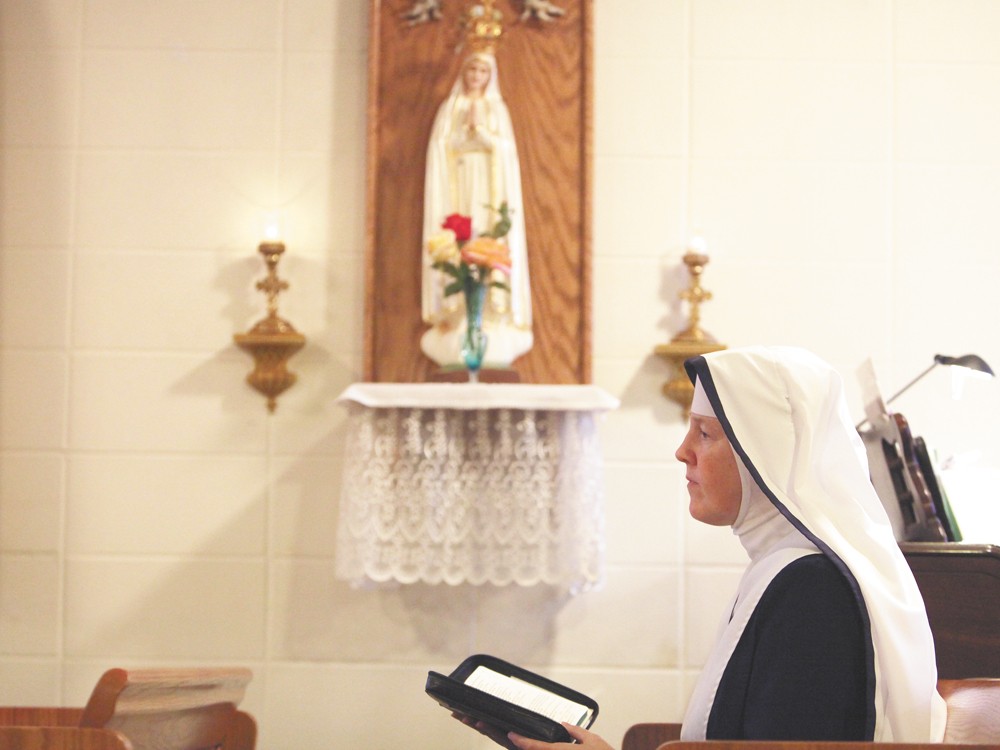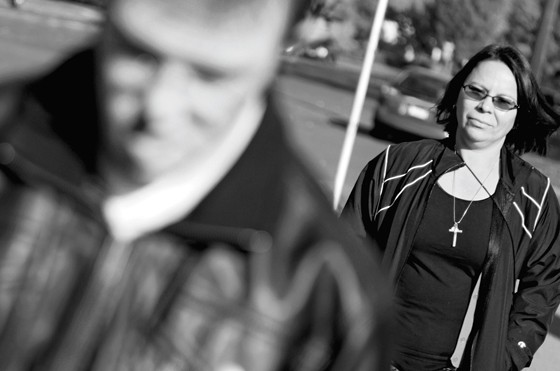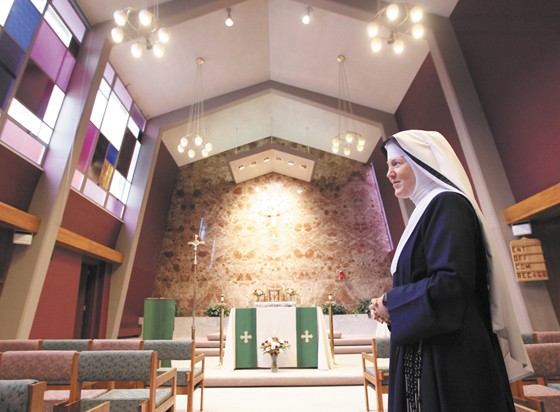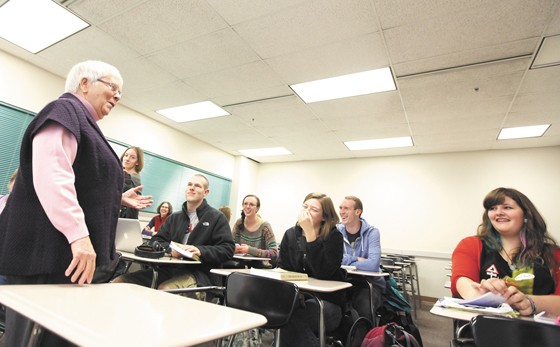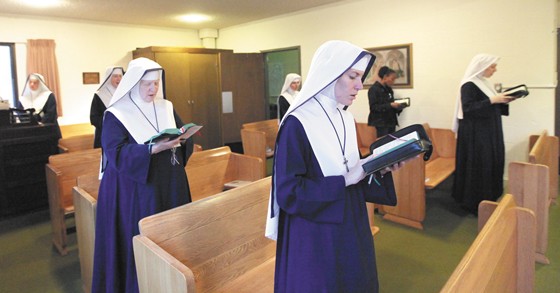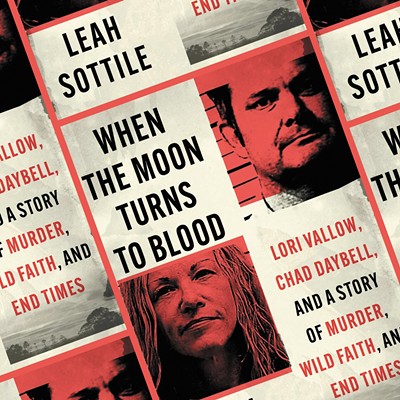It was like a wedding. On Oct. 7, a sunny fall day, Vilma Franco walked down the aisle at Spokane’s St. Aloysius Church — hair carefully curled and pinned back with a sparkling barrette, wearing a flowing, black-and-white dress. A congregation of Catholic nuns in pantsuits, with cropped gray hair and the occasional habit filled the pews, looking through teary eyes as Franco came down the aisle.
At the altar, she accepted a ring — blessed by Bishop Blase Cupich — as a symbol of her commitment and vows as a Catholic sister. With it, she was told to “fear nothing.”
It was also the day when Franco told God, in front of so many nuns who had said so before her, that she was committed to the people who needed her most — the sick, the poor, the oppressed. She knew personally what it was to be hungry and scared, growing up in war-stricken El Salvador, shoeless, running in the mountains to hide with her family and watching, at age 6, as her father was gunned down by the Atlacatl Battalion — the same School of the Americas-trained unit that massacred hundreds, including six Jesuit priests in 1989.
“We grew up with faith,” Franco says. “My mother always said, ‘We have to have faith because God is here, and we are alive because of God.’”
That faith has given Franco strength, a sense of justice, a calling, a belief that women should someday be ordained and serve as priests in the church.
“We cannot only just be praying,” Franco, 33, says. “[Sisters] have to pray. But prayer without action is not prayer. We have to act. We have to have action in order to have faith. Faith without action is not faith.”
Indeed, nuns in America have a long history of action — but it hasn’t always been celebrated by the male-dominated church leadership. In April, the Vatican delivered a scathing assessment of the Leadership Conference of Women Religious, which represents 80 percent of the nuns in the United States. The Vatican said the group had “serious doctrinal problems” and scolded it for promoting “radical feminist themes incompatible with the Catholic faith” while challenging teachings on homosexuality and the male-only priesthood.
The nuns were also chastised for making public comments that “disagree with or challenge the bishops, who are the church’s authentic teachers of faith and morals.” The assessment said the nuns focused their work too much on poverty while staying quiet on issues of same-sex marriage and abortion. In response, the Vatican has appointed the archbishop of Seattle to conduct an overhaul of the group, rewriting its charter and teaching materials.
The public scolding of the nuns — seen as the church’s workhorses in the U.S., operating schools and hospitals — has been met with outrage. Disgust toward the Vatican filled national newspaper editorial pages. The Nun Justice Project, a coalition standing in solidarity with the group, formed. Catholics worldwide held candlelight vigils for the nuns and handed out buttons proclaiming, “I Stand With the Sisters.”
The flare-up with the Vatican represents a blow to American nuns at a time when their numbers continue to drop precipitously, from 180,000 in 1965 to 57,000 today. It also comes as fewer Americans are claiming religious affiliations, with roughly 10 percent of the entire U.S. population claiming to be former Catholics.
But for Franco and many other local sisters, the turmoil only affirms their mission. God, Franco says, carried her from oppression and violence and called her to pledge her life to serving others.
“For me, it gives me more power to say, ‘Yes, I want to continue,” she says. “That, for me, gave me more power to my vocation. There’s something to fight.”
CHANGING TIMES
The conflict facing American nuns can, in some ways, be traced to the 1960s. Catholicism was on the rise in America. Hollywood cast its biggest stars in Catholic roles — putting Bing Crosby in a priest’s collar in the 1945 film The Bells of St. Mary’s and then Audrey Hepburn in a nun’s habit in 1959’s Nun Story. Two years later, in 1961, America elected its first — and so far only — Catholic president in John F. Kennedy.
“We could see that American values were reflected in Catholic values,” says Brother Paul Bednarczyk, executive director of the National Religious Vocation Conference.
With 1962 came one of the most important events in the modern history of the church: The Second Vatican Council — more commonly known as Vatican II — was called to order. Over the next three years, the council would not rewrite the church’s teachings, but drastically modernize it to meet the changing needs of the faithful. In the U.S., Masses were to be celebrated in English instead of Latin. The laity — people who had not taken any vows — could now participate in Mass, performing readings and assisting with the Eucharist.
And Catholic nuns and priests were told to update themselves: become educated, reassess their quiet, cloistered lives and focus on the social struggles of the time. The Vatican also told sisters to modify the long, swaddling habits that they’d worn for centuries, or trade them for something more modern.
“Many of these women, who went into the convent, went in when they were 18 years old. They went into the convent thinking, as nuns, ‘My life is never going to change,’” says Cate Siejk, a professor of religious studies and women’s and gender studies at Gonzaga University. “And now Vatican II presents them with alternatives. They’re no longer in one category. They have possibilities.”
Not all sisters were happy with the changes brought by Vatican II, and because it also increased the role of laity, many Catholic women decided they could both have a family and be devoted to their faith. According to Mary J. Henold’s book Catholic and Feminist, many sisters reconsidered their vocations. While 765 women left their orders in 1960, that number jumped to 2,000 by 1966 — just one year after Vatican II. In 1970, 4,337 women left the convent.
Sister Joy Milos, a Catholic nun, theologian and professor of religious studies at Gonzaga University, entered the community of St. Joseph of Carondelet in 1963 in full habit, only to shed it soon after.
“I lived in two different worlds,” she says of the shift. “Everything that we were [initially] told was unchanging — that would never change — was gone.”
For women like Milos, the door was suddenly thrown open to a life and an education she never knew could be hers. A theology degree. A Ph.D in Christian spirituality. They were still women religious — as they are formally known — but they, too, could be modern, educated, empowered women.
Many of these nuns who stayed on would overhaul what it meant to be an American Catholic woman. Suddenly they were not only helping the people who needed it most, but were calling for social change. In 1971, 47 sisters formed NETWORK — a lobbying organization devoted to seeking social justice legislation in Washington, D.C. Sisters worldwide joined the frontlines of war protests and immigration protests. One woman — Sister Megan Rice of New York — has been arrested “40 or 50 times” for acts of civil disobedience in protesting nuclear weapons, according to a Boston Globe article. Just this year, Sister Simone Campbell spoke at the 2012 Democratic National Convention on issues of social justice.
“Sisters were living testaments that women did not need to define their identity through marriage and motherhood,” Henold writes in Catholic and Feminist. “They had long rejected both to live and work in communities of women.”
At the same time, some sisters and female Catholics started to look inward at the institution they represented. Despite Vatican II’s changes, women still could not truly serve as leaders within the church. Women religious wanted to lead congregations and to be at the table making decisions about the direction of the Catholic church.
Worldwide, sisters began to ask a question that would get them in trouble time and again: Why can’t we be priests?
PARENTAL CONTROL
In 2002, a boat floated down the Danube River in secret. Everyone aboard knew that soon — within weeks or even days — they would all be excommunicated from the Roman Catholic Church. On the river, bordering Austria and Germany where no bishop has jurisdiction, a bishop ordained seven women as Catholic priests.
And again, in 2005, a bishop named nine more women priests on a boat travelling on the St. Lawrence River, between the United States and Canada.
They call themselves Roman Catholic Womenpriests and, according to a 2011 New York Times article, have 120 female priests and five female bishops in their ranks. While they have all been excommunicated, Erin Hanna, executive director of the Women’s Ordination Conference, says these women continue to hold services in progressive Christian churches and even in people’s homes.
Actions like these have long been condemned by the Vatican.
As Episcopalians, Methodists and Presbyterians began to ordain women as priests in the 1970s, Catholics worldwide began to express support for female ordination. In 1974, Pope Paul VI issued Inter Insigniores, a document that said that the church was not authorized to ordain women. Just one year later, the Women’s Ordination Conference (WOC) was founded, bringing more than 2,000 supporters to its first meeting.
Dissatisfied with the Vatican’s unwillingness to discuss the issue, in 1979 three members of the WOC held an all-night vigil in Washington, D.C., where Pope John Paul II was staying. They greeted him in the morning with calls to “ordain women!”
Later that day, Sister Theresa Kane, then president of the Leadership Conference of Women Religious, gave a speech pushing for women’s ordination to a packed room of nuns and the pope himself. As she talked, 30 women in blue armbands — a symbol of the female ordination cause — stood in support.
In 1994, though, in his Ordinatio Sacerdotalis letter, Pope John Paul II proclaimed the issue of women’s ordination officially closed. “I declare that the Church has no authority whatsoever to confer priestly ordination on women,” he wrote. “And that this judgment is to be definitively held by all the Church’s faithful.”
Expecting an entire church around the world to fall in step with the Vatican and stop talking about female ordination is a sign of how threatened the male hierarchy of the church feels, says Siejk, the Gonzaga professor.
“[That Vatican seems] incredibly fearful ... of having their power and privilege taken away from them,” she says. “I think any attack on their power and privilege, or what they see as an affront to their power and privilege, is so frightening to them that they will do anything to keep it.”
Siejk says that female ordination is one of many things that have recently upset the Vatican — and could be what earned them the label of “radical feminists” in the doctrinal assessment.
“Women are being systematically excluded not only from leadership, but from the sacramental system,” she continues. “You’re being told you cannot engage in the sacrament of ordination because you do not have a penis. Did God come down and say, ‘The only way you can be a priest is if you have a penis?’”
She pauses, smiling.
“It is nowhere in the Bible. I think you’d have a hard time finding that.”
Colleen Carroll Campbell, author of My Sisters the Saints, says calls for female ordination are just one example of how Catholic nuns have gone too far since Vatican II.
“The call to be engaged with the world was not a call to throw the baby out with the bath water, doctrinally speaking or in any other way,” she recently told NPR. Sisters, she says, took the message of Vatican II and ran with it — and that’s not what the Vatican Council intended.
“Nowhere in those documents is there this vision of the church having a radical break with its 2,000-year history, and now, at the Second Vatican Council, everything is up for grabs,” Campbell says.
But Siejk says that Vatican II made women think critically about how they fit into the church. Or if they even fit at all.
“I think that I’ve struggled with that through my career,” Siejk says. “As a feminist theologian, I am part of an institution that is institutionally patriarchal, misogynistic and sexist.”
Meanwhile, nuns in America face a problem from within: their numbers are declining, and many of the new sisters who are joining want to go back, to the times of the habit.
STRICT CONSTRUCTION
In the place where Spokane’s South Hill transforms from shopping centers and houses into rolling hills and bright yellow fields, the Sisters of Mary, Mother of the Church are singing.
It’s 5:15 pm, and the Sisters have gathered in a small chapel in the Immaculate Heart Retreat Center, where they have lived since 2007. As the sun paints the sky crimson and deer lazily graze on the grass outside, a dozen sisters — in long blue habits — harmonize in prayer. They sing “Amazing Grace” — many with their eyes closed and heads bowed. It is a scene of solitude and peace.
A tight-fitting white coif around her face and a long rosary clicking at her side, Sister Mary Eucharista Mazurik explains that her community wears the habit everyday — regardless of what they’re doing. Aside from her freckled cheeks and bright blue eyes, it is impossible to tell what she looks like.
“In giving the sacrifice of my life, I also gave the sacrifice of all my clothes,” she says.
Though habited communities of sisters like Sister Mary Eucharista’s are a minority, in its 2009 report on religious vocations, the National Religious Vocation Conference found that “having a religious habit was an important factor” for many women entering the sisterhood.
While it’s a symbol that largely fell out of popularity after Vatican II, the habit is something that seems to be regaining popularity — but for different reasons than it was initially worn, according to Bednarczyk of the National Religious Vocation Conference.
“Back in the ’60s, it was very radical when the sisters removed their habit,” Bednarczyk says. “To wear a religious habit today in the climate that we live in with the Catholic church — it’s a very radical statement today.”
Mazurik says that when the Catholic church was entrenched in scandal worldwide from sexual abuse cases, she found that the nun’s habit seemed healing to some people — something she still thinks now.
“It’s almost like balm on the wound of what had happened here,” she says. “And we were so touched to hear that … we didn’t know they were actually really hungry to see us in habit.
“Today in the store, I met a couple,” she adds, “and they said ‘Sister thank you for wearing your habit.’ … Every day we experience this.”
A study by National Religious Vocation Conference found that Millennial Generation sisters and priests are “much more likely than other respondents — especially those from the Vatican II Generation — to say that daily Eucharist, Liturgy of the Hours, Eucharistic Adoration, and other devotional prayers are ‘very’ important to them.” Older men and women religious “place greater importance on faith-sharing and, to a lesser degree, on non-liturgical common prayer.”
With or without the habit, the sisterhood is simply not at the numbers that it used to have. The religious study also found that “overall, religious are an aging population.” A staggering 91 percent of women religious are 60 or older, as opposed to 75 percent of male religious. And new entrants aren’t fresh out of high school anymore like in the 1950s and ’60s — in fact, the average age of a new sister is 32.
And for Bishop Cupich of Spokane, that’s a major concern.
While Cupich says between 500 and 600 males are being ordained priests in the United States — which is in no way “hitting the ball out of the park,” he says — the numbers are far lower for women religious.
“[Male religious are] able to keep up with the present needs that we have,” he says. “That’s not the case with religious sisters. They’re having a more difficult time.”
Low numbers mean the institutions that sisters have run for decades — schools, orphanages, hospitals — cannot continue to function.
Some wonder, could Catholic nuns become extinct altogether? Sister Joy Milos, of Gonzaga, says that’s certainly possible. Milos estimates that more than 70 percent of Catholic orders have disappeared over the church’s long history.
“If you look at the cycle of history of religious institutions, there’s this interesting kind of bell curve,” she says. “They tend, over long periods of time, to go into decline.”
KEEPING THE FAITH
On a recent Sunday, Mary Ellen Gaffney-Brown and four of her friends pinned notes to their shirts as they entered Mass at St. Ann’s Church in Spokane’s East Central neighborhood. On sheets of printer paper, Gaffney-Brown wrote “ORDAIN WOMEN” in wide marker. “We’re done talking about it,” she says. “We’re going to do something bodily.”
Gaffney-Brown, a 59-year-old “cradle Catholic” who is “a product of 19 years of Catholic education, from kindergarten through law school,” says her faith has gotten significantly more complicated in the past few years as she’s watched nuns come under scrutiny from the Vatican. She’s seen her closest friends — also lifelong Catholics — leave the church, upset over its unwillingness to change and make more room in leadership for females.
The sign on her shirt was not the first statement that Gaffney-Brown has made in her church. When the Vatican’s doctrinal assessment criticizing the nuns’ group was released earlier this year, she was quick to affix a button to her clothing that read, “I Stand With the Sisters.”
“They’ve been doing the work that Jesus instructed us to do. Nowhere in the Gospel does it say, ‘Build new buildings, establish a church institution, I would like a hierarchy.’ … What Jesus said was: ‘Feed the hungry, care for the sick.’
“The way it made me feel was [that] now they’re trying to take us back before Vatican II when [sisters] never did anything unless Father said it was OK,” she continues. “They’re trying to close the doors after Vatican II blew the doors wide open.”
The situation was the latest in a series of disappointments that Gaffney-Brown has experienced in recent years as a Catholic. To her, the last people who should be criticized are American nuns.
“The church responds to the reality of the world by stressing and imposing from the top down. The same dogma, the same lock-step, non-sentimental rules,” she says. “So instead of looking at the world and saying, ‘Look at how hungry people are for spirituality,’ the church says, ‘We better rein in the ones who are living at the margin.’”
Gaffney-Brown is hardly alone in that opinion. After the Vatican’s report was released, a coalition of several Catholic organizations — including the Women’s Ordination Conference — formed the Nun Justice Project to show solidarity.
“Our phone in our office was literally ringing off the hook. The same people who support women’s ordination are the same people who work with the sisters at soup kitchens and schools,” says Erin Hanna, of the WOC. “Literally by the next day, people wanted to do something.”
After the WOC aided in forming the Nun Justice Project, a petition was launched that, over a series of months, gathered 64,000 signatures in support of the sisters.
But for Linda Kobe-Smith, who also attended St. Ann’s for years, this latest tension over women religious was sad, frustrating and demeaning.
“It wasn’t surprising having watched the conservative turn in the church and what I perceived as a [discomfort] with really competent women in the church,” she says.
Even more, Kobe-Smith realized that the people making decisions about her life — celibate males — were hardly keeping Catholics like her in mind.
And so Kobe-Smith did what she never thought she would do: she stopped taking Communion on Sundays. “I cannot say ‘amen’ to the doctrines of the church,” she says.
A year and a half ago, she stopped attending the Roman Catholic Church altogether.
“When I open the paper and read what Roman Catholic sisters are doing, or Catholics United for R-74, that makes me feel really proud,” she says. “When I look at what the hierarchy does, it makes me feel sad and it makes me feel embarrassed. … [They say] ‘we’re not going to advocate for health care, we’re not going to advocate for women, we’re not going to stand up for our gay and lesbian brothers and sisters.’”
To Kobe-Smith, it’s a battle that can’t be won.
“I’m not going to fight for my place here. Either I’m wanted or I’m not,” she says. “God is bigger than the Roman Catholic Church.”
But for Gaffney-Brown, remaining a member of the Catholic church means she can help push for change, even if it’s something she might not see in her lifetime.
“As a woman in the church, the message is quite clear: ‘You will always be second-class citizens in our eyes. Never in your lifetime will we ordain women,’” she says. “I don’t believe that we can change [the church] by leaving it. And I refuse to let transient leadership take away my church. Because that’s what they are: Just like John Paul, [Pope] Benedict will die. Just like the priests are rotated in and out [of parishes].”
The church, to her, is not the hierarchy of men in Rome. It is not the pope. It is not priests. It is the living, breathing church.
And God, she says, is in the faces she sees in the pews on Sunday mornings.

